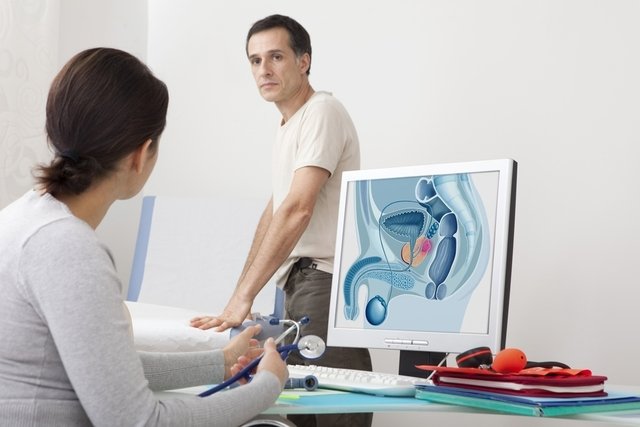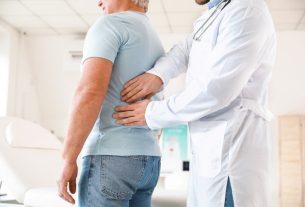An enlarged prostate is a very common problem in men over 50 years of age, and can cause symptoms such as a weak stream of urine, a constant feeling of a full bladder, the need to strain to urinate or dripping urine at the end of urination, for example.
In most cases, an enlarged prostate is caused by prostate hyperplasia, a benign condition that only causes an enlarged prostate, however, it can also be a sign of more serious problems, such as prostatitis or prostate cancer, which lead to compression of the urethra, which is the channel through which urine passes, resulting in symptoms.
Therefore, whenever there is a suspicion of an enlarged prostate, it is advisable to consult a urologist to carry out the necessary tests to identify its cause and begin the most appropriate treatment. Check out the 6 exams that help assess prostate health.

Enlarged prostate symptoms
The main symptoms of an enlarged prostate are:
- Difficulty urinating;
- Weak stream of urine;
- Interruption of the urine stream;
- Spending a long time urinating;
- Dripping of urine at the end of urination;
- Frequent urge to go to the bathroom;
- Urgency to urinate;
- Need to strain to urinate;
- Bladder feeling always full;
- Urinary retention;
- Urinary incontinence, especially at night;
- Increased urinary frequency at night.
These symptoms usually appear after the age of 50 and occur in at least half of cases of enlarged prostate. This occurs due to the compression that the prostate makes on the urethra, which is the channel through which urine passes.
Since these symptoms are also present in other health conditions, such as prostatitis or prostate cancer, for example, you should consult a urologist for tests, diagnose prostate enlargement and begin the most appropriate treatment.
Don’t ignore your symptoms!
Symptom Test
To find out your risk of having a prostate problem, select what you are feeling:
The symptom test is only a guidance tool and does not serve as a diagnosis and does not replace consultation with a urologist.
How to confirm the diagnosis
The diagnosis of an enlarged prostate is made by the urologist through the evaluation of symptoms, as well as when the symptoms started, health history, family history of prostate hyperplasia or prostate cancer, and digital rectal examination, which allows the doctor to evaluate if there is an enlarged prostate, changes in consistency and if there are nodules or other changes. Understand how a rectal examination is performed.
In addition, the doctor may also order prostate ultrasound, urine tests, PSA test, urinary flow test, post-void residual volume test, or even ask the man to keep a 24-hour diary of how many times he urinated. and associated symptoms, as they help identify the cause of the enlarged prostate.
If the doctor identifies changes during the rectal examination or if the PSA value is above the reference value for age, additional tests such as MRI and even a prostate biopsy may be necessary to assess the possibility that the increase is occurring. be caused by cancer.
Possible causes
Most situations in which the prostate is enlarged are cases of benign prostatic hyperplasia (BPH), which appears with aging and presents symptoms of slow progression, and treatment is generally only started when symptoms that interfere with the patient’s quality of life are presented. patient.
However, an enlarged prostate can also be caused by more serious diseases that need to be treated, such as prostatitis or cancer, for example. Prostatitis typically affects men at a young age, while cancer is more common with advancing age.
In the case of men who have a family history of prostate cancer, they should have a digital rectal examination earlier than usual, around the age of 45, in order to avoid complications, aiming for an early diagnosis.
How the treatment is carried out
Treatment of an enlarged prostate must be carried out under the guidance of a urologist, and varies according to its cause and the severity of the symptoms.
The main treatments that may be recommended by your doctor are:
1. Medicines
Treatment for an enlarged prostate usually begins with the use of medications that help alleviate symptoms and avoid complications such as urinary retention or kidney stones, for example. Some of the remedies most recommended by urologists include:
- Remedies to relax prostate musclessuch as alpha-blockers which include tamsulosin and doxazosin;
- Remedies to reduce the action of hormones on the prostatemaking it reduce in volume, such as finasteride and dutasteride;
- Antibiotics to reduce prostate inflammation, if any, such as ciprofloxacin.
These medications can be used separately or in combination, depending on the symptoms presented and the size of the prostate.
In cases where a man also has prostate cancer, the doctor generally recommends surgery to remove the prostate, as well as radiotherapy and/or chemotherapy to eliminate the malignant tumor cells.
2. Surgery
Surgery to treat an enlarged prostate is indicated in the most serious cases, especially when a bladder catheter is used to urinate, when there is a large amount of blood in the urine, when there has been no improvement with clinical treatment or when the person has bladder stones. or kidney failure, for example.
The most commonly used surgical techniques include:
- Prostatectomy/adenomectomy: consists of removing the internal part of the prostate through normal abdominal surgery;
- Transurethral resection of the prostatealso known as classic endoscopy: the removal of the prostate is done with a device that is introduced through the urethra;
- Electrovaporization of the prostate or GreenLight: it is similar to transurethral resection but uses a thermal reaction, resulting in faster hospital discharge.
In addition to these surgeries, in some cases, just a small cut can be made in the prostate to facilitate the passage of the urethra, without having to remove the prostate.
3. Natural treatment
In addition to treatment with medication, it is possible to use natural extracts to help alleviate symptoms more quickly. However, this type of treatment should not replace the treatment recommended by the doctor, but should only complement it.
A good natural treatment option is saw palmetto, which has excellent anti-inflammatory and diuretic properties that help to reduce inflammation of the prostate and facilitate the passage of urine, relieving the symptoms of an enlarged prostate. To use saw palmo, it is recommended to take 1 capsule at breakfast and dinner. Another option is to take 1 teaspoon of saw palmetto powder mixed in a glass of water, twice a day. Learn more about saw palmetto.
Furthermore, the medicinal plant can also be used African pygmy which helps to alleviate the frequent urge to urinate, and can be found in capsule form in health food stores and should be taken in doses between 25 and 200 mg per day. See other home remedies for the prostate.
How to relieve discomfort from an enlarged prostate
To improve the discomfort caused by an enlarged prostate, some tips are:
- Urinate whenever you feel likeavoiding holding urine;
- Avoid drinking too many liquids at oncein the late afternoon, before bed or in places where there is no bathroom;
- Do physical exercise and physiotherapy to strengthen the pelvic muscles. See how to do this type of exercise;
- Urinate every 2 hourseven without the will;
- Avoid spicy foods and diuretic drinkssuch as coffee and alcoholic beverages, orange, lemon, lime, pineapple, olives, chocolate or nuts;
- Do not leave urine dripping at the end of urinationsqueezing the urethra, to avoid infections;
- Avoid medications that cause urine retentionas a nasal decongestant.
Additionally, men who easily develop constipation should increase their water intake and laxative foods to stimulate bowel function, as constipation can worsen the discomfort of an enlarged prostate.

Sign up for our newsletter and stay up to date with exclusive news
that can transform your routine!
Warning: Undefined array key "title" in /home/storelat/public_html/wp-content/plugins/link-whisper-premium/templates/frontend/related-posts.php on line 12
Warning: Undefined array key "title_tag" in /home/storelat/public_html/wp-content/plugins/link-whisper-premium/templates/frontend/related-posts.php on line 13




